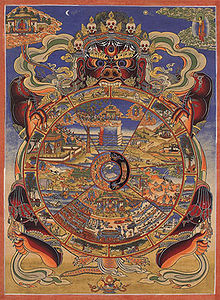Saṃsāra
![]()
The title of this article is ambiguous. For other meanings, see Samsara (disambiguation).
![]()
This article or subsequent section is not sufficiently supported by evidence (e.g., anecdotal evidence). Information without sufficient evidence may be removed in the near future. Please help Wikipedia by researching the information and adding good supporting evidence.
Samsara (Sanskrit, n., संसार, saṃsāra; Pali: saṃsāra; literally, "perpetual wandering") is the term for the perpetual cycle of being, the cycle of becoming and passing away, or the cycle of rebirths in the Indian religions of Buddhism, Jainism, and sub-currents of Hinduism and Manichaeism.
In some Indian religions this cycle is regarded as suffering (see Dukkha). The break out of this unholy cycle happens on the way of letting go of all attachments, desires and wishful thinking as well as through cognition. The state of "salvation" (and according to some variants of eternal bliss, see salvation) is reached, which the Hindus call moksha and the Buddhists nirvana.
Samsara is vividly depicted in the so-called Wheel of Life, which is widely used in Tibetan Buddhism. In the center, around the hub, the driving forces of the wheel are depicted, the three mental poisons: greed, hatred and delusion, as a rooster, snake and pig. The cock symbolizes greed, the snake hatred, and the pig ignorance. Following this, the result of actions based on the mind poisons is shown as descending path black, the path of overcoming these mind poisons is shown as ascending path white. These paths lead to the six possible rebirth realms shown on the next level: White (from top to bottom): gods (devas or suras), asuras, humans. Black (from top to bottom): animals, hungry ghosts (pretas), hell beings. Thereby the extent of suffering increases continuously from the god realm downwards to the extreme suffering experiences and the different hell realms (cold, hot, great hells).
However, a human form of existence is best suited for attaining nirvana, as one does not experience excessive suffering or happiness as a human being. In a god form of existence, one's sense of happiness is so strong that one will see no reason to break out of this existence in samsara. With a form of existence as an animal, one does not have the mind necessary to break out of samsara, and with a form of existence as a hungry ghost or hell being, one has difficulty doing so due to the predominance of suffering. In the outer area, the twelve limbs of dependent arising are pictured, where not knowing (Sanskrit "avidya", Pali "avijja") is at the beginning/end of the whole cycle.

Cycle of life in suffering samsara
See also
- Karma
- Reincarnation
Questions and Answers
Q: What is Samsara?
A: Samsara is a Buddhist term meaning the conditioned state of mind.
Q: What does Samsara lead to?
A: Samsara leads to disturbing emotions and clumsy actions which cause suffering and new disturbing feelings.
Q: What are the three main disturbing feelings according to Buddha's teachings?
A: The three main disturbing feelings are ignorance, anger, and desire.
Q: What are the three poisons of the mind?
A: The three poisons of the mind are ignorance, anger, and desire.
Q: How many combinations of the three poisons of the mind are there?
A: There are told to be 84,000 combinations of the three poisons of the mind.
Q: What is the goal of all Buddha's teachings?
A: The goal of all Buddha's teachings is to reach Nirvana or the perfect state of Buddha.
Q: How can one completely get rid of suffering according to Buddha's teachings?
A: According to Buddha's teachings, one can completely get rid of suffering by reaching Nirvana or the perfect state of Buddha.
Search within the encyclopedia